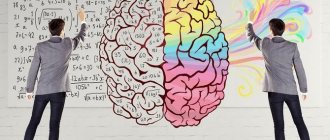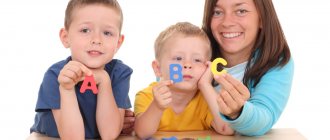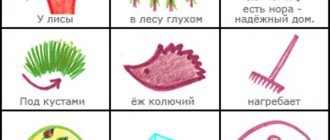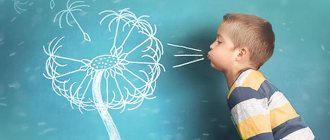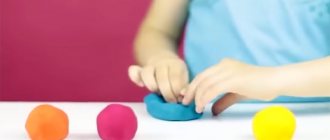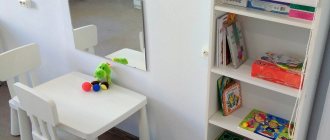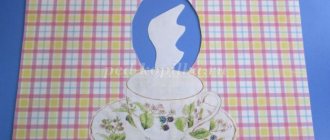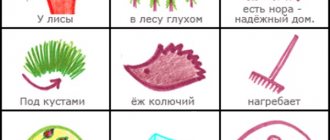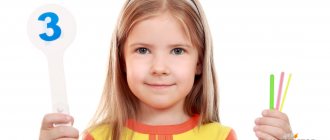When introducing children to objects and phenomena of life around them, their main assistants are sight and hearing. The resulting visual images are imprinted in the children’s memory, creating a reliable picture of the world. Therefore, it is so important from a very early age to develop auditory and visual perception of various objects, on its basis improving attention and memory. Visual memory requires special work, which subsequently has an important impact on the child’s intellectual development. To help preschool children fully master all the techniques of visual perception, parents need to know how to properly develop their child’s visual memory in home activities.
Types of memory
Memory is a complex mental process. Depending on what type of information needs to be remembered, how this happens, how long the information is stored in memory, different types of memory are distinguished.
| Criterion | Types of memory |
| By information storage period |
|
| By object of memorization |
|
| According to the form of storing information in memory |
|
| On the participation of the will in memory processes |
|
| On the participation of thinking in memory processes |
|
Each of us has some types of memory developed better and others worse. For example, some people perceive information well by ear, while others have a photographic memory. When working with a child, you need to try to pay attention to all types of memory, since in preschool age mental processes are plastic and develop more easily than in adults.
Auditory memory disorders
It happens that a child experiences difficulties in perceiving speech, when isolating it from the surrounding noise, cannot immediately understand tasks and commands received orally, when mastering new words or learning languages. These problems may not be related to attention deficits or lack of motivation, and may not be the result of bad behavior. Perhaps the reason lies in auditory neurological disorders. Disorders of auditory processing may be associated with traumatic brain injury, long-term inflammation of the middle ear, birth trauma, and other causes. In such cases, consultation with a specialist is necessary. Treatment, as a rule, includes several areas: improving cognitive and speech skills, improving the perception of auditory information, improving the quality of the auditory signal.
Peculiarities of memory of preschool children
In children of primary preschool age, figurative memory predominates. Babies can remember people's faces, voices, melodies, tastes and smells. They remember information mainly mechanically, involuntarily. That is, a small child remembers what interests him or what makes a strong impression on him. Therefore, an unusual and vivid form of presenting information is very important. With the development of speech, the ability to perceive words increases: a preschooler can memorize poetry, he easily remembers the plots of fairy tales and cartoons. At preschool age, motor memory also actively develops. By repeatedly repeating the same actions (for example, learning a dance or working with scissors), the child gradually remembers them.
Do not forget that the leading activity of preschoolers is play. Therefore, it is better to present information that needs to be remembered to the baby in a playful way.
In older preschool age, the child begins to form voluntary memory. With the development of the ability to self-control, the baby learns to independently remember information that may be useful to him. However, this requires motivation, that is, the child must understand why he needs to remember something. Voluntary memory develops more actively if you encourage the baby to reproduce accumulated experience: ask the child what happened during the day, ask him to tell fairy tales from pictures, and so on.
Visual memory test
Before you start the exercises, you need to determine how difficult it is for your child to remember pictures.
To do this, he should lay out 10 images of objects, different in shape, color and purpose, in front of him. For 30 seconds the child looks at them and tries to remember them. Then the pictures are turned over, and the child tells from memory which objects he remembers. If you managed to name less than 5 objects, then you need to pay attention to visual memory training. But for children who have shown fairly high results, it also wouldn’t hurt to do the exercises from time to time.
IMPORTANT!
Before the child begins the tasks, it is worth explaining that his task is to remember the drawing and the objects that will be shown to him. And after he closes his eyes, he needs to imagine an image of what he saw.
Games for developing visual memory
- "What changed?" Place several objects (or cards) on the table in front of the child. Give your child time to remember them. After this, ask the child to close his eyes or turn away, and you yourself change places or remove one of them. Opening his eyes, the child must say what has changed.
- "Remember and Draw" . Show your baby a picture for 1 minute (the more small details there are, the more difficult the task), and then ask him to draw what he remembers.
- “Describe your neighbor . This game is suitable for a group of children. The kids are given the task of remembering what their neighbor looks like. After this, he is asked to turn away and describe from memory the appearance and clothing of his comrade.
To make it more interesting for your child, in this and other similar games you can invite him to “be the camera.” The baby can use gestures to depict how he takes pictures, as well as voice the click of the shutter. The game situation properly motivates the child and mobilizes his abilities.
- "Way home" . While walking with your baby, being quite far from home, ask your child to show you how to get back to home. Along the way, pay attention to places where you can navigate, for example, shops, trees, playgrounds.
- "Memory" . This game consists of paired cards or chips. Before starting, they are all mixed and placed face down on the table. Players take turns turning over two chips, and if they are the same, they take them for themselves and open the next ones. If the chips do not match, then the move goes to the opponent. The goal of the game is to collect as many paired chips as possible.
Basic Workouts
Maximum results can be achieved with the help of corrective training. It is recommended to perform them daily, combining 2-5 types of exercises. At the same time, you should not overexert yourself by forcing yourself to study for too long, because... this approach will do more harm. Everything has its own measure.
The presented exercises are aimed at developing visual memory in adults, but can be used for high school students. In the second case, it should be taken into account that not every teenager will be able to cope with some tasks. Therefore, they can be slightly simplified.
Exercise 1
The first exercise is like a mini-training with looking at an object. Its essence is approximately the same, but there are a number of conventions that significantly complicate the task, increasing the effectiveness of classes.
How to do it:
- Examine any object that comes to hand, inhaling air (5 seconds).
- Close your eyes, imagine this object, holding your breath (3 seconds).
- Dissolve the image of the object in your thoughts, exhaling slowly.
The exercise must be repeated many times, changing the rhythm of all actions every 5 times. It is recommended to perform it 2-3 times a day for 10 minutes. Gradually, the time should be increased until the number of repetitions increases to 50.
Exercise 2
This exercise will require outside help. It is advisable that this be one of the close people with whom it will be comfortable to work. If you wish, you can train in both directions, i.e. alternately, changing roles.
The essence of the exercise:
- The assistant writes different words in the form of a diamond on a piece of paper. The top and bottom words should be the shortest, and the length should increase towards the middle.
- The trainee must look at this diamond for 10 seconds, and then reproduce the words he saw on a separate piece of paper.
- At the end of the word, you need to check and determine how correctly the test taker was able to visually remember and write everything.
It is important that the given words are similar and start with the same letter, otherwise it will be very difficult to learn them in such a short period of time.
Exercise 3
Many adults remember how in childhood they solved various puzzles that used matches. In training using this method, they will also be needed, but they will be used to engage attention and figurative memory. To complete the exercise you will need the help of a second person.
How to train:
- The assistant must arrange the matches in such a way as to form a certain figure. It is best to complicate the task by using two or three matches side by side in some places.
- The trainee must look at this picture, but cannot hold his gaze for more than 3 seconds. After this, the assistant should cover the matches with paper.
- The trainee’s task will be to reproduce the picture he saw using other matches, taking into account all its features.
You can complicate the task by including matches of different colors in the picture. The more correctly the trainee composes the image, the better.
Exercise 4
You can practice this exercise to develop visual memory on the way home from work or during an evening walk. No assistance is needed in completing the tasks, which makes the method more versatile and easier. However, you will need to be especially careful during training.
Procedure:
- Stop suddenly, fixing your gaze for a second at any point where there is a sufficient number of different objects that can be remembered. Close eyes.
- Restore figuratively the picture you just saw, remembering as many small details as possible. Hold it in your head for several minutes, filling it in from memory.
When attempts to remember are completed, you can visually evaluate reality and compare it with what was formed in your thoughts.
Exercise 5
The last exercise will also allow you to use your imagination and general intellectual capabilities. It must be performed outdoors, because... you will need to see other people. The method involves creating figurative stories in your head, which will be based on real people you have seen.
Performing the exercise:
- Choose a suitable bench on the street where it is not too noisy.
- Pay attention to any passerby, remember his appearance.
- Close your eyes, imagine how he moves on and what will happen.
It’s best to start with visualizing a simple walk, and only then come up with more detailed and unusual situations. You shouldn’t try too hard and write long stories either, unless the goal is to develop imagination.
If you perform these exercises only occasionally, you will not be able to achieve the desired result. Only regular training will be beneficial.
Exercises to develop auditory memory
- "Words" . This game is very similar to the well-known game "Cities". It not only develops the child’s memory, but also promotes the transition of words from a passive to an active vocabulary, and also improves phonemic hearing. So, name the word and ask your child to come up with a word starting with its last letter. Then you do it, and so on in a circle. Another version of this game is to name words starting with one pre-selected letter.
- "10 words" . Invite your child to remember 10 words that are not related in meaning. Read the words at a moderate pace, taking a short break between them.
- Retellings.
- Learning songs and poems.
- "Remember how your day went".
Auditory memory in children
Auditory memory is a type of figurative memory, which consists of processes such as imprinting, storing and reproducing auditory images.
The ability to learn through oral explanations and instructions is considered a fundamental skill that will be useful throughout life. Good auditory memory is necessary for mastering the rules of orthoepy, intonation skills and expressive reading. Poor hearing skills can lead to difficulties in mastering reading skills, learning languages and spelling rules.
Developing a baby's associative memory
- “I know five... ” The game is to repeat the name of something while hitting the ball. For example: “I know five cities: Moscow one, St. Petersburg two, Vologda three... and so on.”
- "Name a couple" . Give your child 5-6 pairs of words that are related to each other in meaning (for example, soup - spoon, winter - snow, TV - cartoons). Then ask your child to remember the second word from each pair in response to the first. Gradually the number of word pairs can be increased.
Educational games and exercises for training visual memory
"Find the Differences"
The task is accessible and interesting for both kids and older children.
An adult selects two identical pictures with a certain subject or plot, but differing from each other in some details. For three-year-old children - up to 5 differences; older preschoolers can be offered 10 differences. Parents should take into account that for children the images should be large, without small details, since children are still learning to concentrate on the subject. Exercises should be carried out as often as possible, gradually complicating the plot.
"Photographers"
The exercise is intended for middle and older preschool children who are already beginning to develop voluntary actions. An adult gives instructions, asking to look at a card divided into two parts. On the left are cells with depicted objects. On the right are empty cells in which you need to draw memorable figures. The child looks at the images for 10 seconds, trying to remember them. Then the left part with the drawings is closed, and the empty cells are filled with drawings. At the initial stage, it will be difficult for a preschooler to remember the images, so the exercise must be repeated quite often. To maintain interest, you need to change the pictures, introduce a competitive element to see who can remember the most figures.
"Symmetrical drawings"
The task is quite difficult, but it develops well the memorization of visual images, teaches you to concentrate on an object, and strengthens motor skills.
An adult prepares a symmetrical drawing for a preschooler, which is divided in half by a vertical line. The left half is painted, the right half remains unpainted. The child is asked to carefully examine and remember how half of the figurine is painted. Then the left side is closed, the right side is painted in the same way. For very young children, you can use this task, but the proposed item should be quite simple and understandable: a vase, a ball, a flower, a cube, a sun (2 colors). For older preschoolers, the image becomes more complex, the number of colors gradually increases to 5, for example, a human figurine, a house, a complex flower, a multi-colored vase, a butterfly, a geometric pattern.
As a variant of the game, you can invite children to complete a symmetrical picture when only one half is given. You just need to remember that a symmetrical object should not have too many small details. For example, the following objects are offered for drawing: plate, chair, daisy, house, Christmas tree, bee.
"Let's help the artist"
The exercise helps develop visual sensations, short-term memory, and attention. The task comprehensively develops imagination and motor skills. An adult selects drawings that lack some details, for example, a teapot without a handle, a flower without leaves, a house without windows. Children are asked to help an absent-minded artist who forgot to draw the details. For older children these could be story pictures:
- the dog sits near the booth, which has no hole;
- a house with a fence that is missing several planks;
- the girl has a handbag without a handle in her hands, no shoes on her feet;
- boys are playing football, but there is no ball, one player is missing sneakers.
Parents can pick up similar stories from children's magazines or draw them themselves. The main thing to remember is that the complexity of tasks should increase gradually: drawing parts begins with one, gradually moving to three or more parts.
“Why so much confusion?”
A game similar to the previous one also contributes to the development of visual memory in preschool children and the formation of attentiveness as a personality quality. An adult selects pictures that depict objects or fairy-tale characters with incorrectly drawn details, for example, Cheburashka has a long tail, like a crocodile, a girl’s cap is on the wolf’s head, sheep are sitting on a branch, a mouse is chasing a cat, and the like. The child is given instructions: carefully examine the drawings and correct the artist’s mistakes. This game amuses the kids and brings them pleasure, so the drawings can be given for independent drawing.
"Cut pictures"
A classic educational game for visual memory and attentiveness for both very young children and older preschoolers. The task is that the children are offered a set of cards and a plot picture. You need to carefully examine it and collect a similar one from individual cards. Using the same principle, you can collect pictures - puzzles.
“Matches are not a toy, but training”
Games with matches are of great benefit for training visual memory, attention, and motor skills. Such fun is good because it does not require long preparation; it can be done anywhere: on vacation, on a walk, during family leisure. The presenter distributes a small number of matches to all players, then throws several of them on a flat surface. The players carefully examine the resulting combination, then the matches are closed. Everyone is trying to repeat the layout of matches. The one who gets it most accurately wins. You can celebrate the winner with a prize, especially if it is a child. In the future, the number of matches increases, the situation becomes more complicated. Fun with repeated repetition brings good results, and game elements allow you to form arbitrary actions.
Games for the development of motor and tactile memory
- "Hands Remember" . Place several objects in an opaque bag that differ in texture (these could be animal figures or geometric shapes). Prepare photos of these items or draw them in advance, and also add pictures of things that are not in the bag. Ask your child to feel all the objects in the bag, and then say which of the objects suggested in the pictures were there.
- "Graphic dictation" . Draw a simple pattern on a sheet of paper in a box and ask your child to continue it. Then give your child a blank sheet of paper and ask him to reproduce the pattern he drew earlier.
- "Puppets" . Ask your child to close his eyes, stand behind him and, holding his shoulders, guide him along a certain route, for example, two steps forward, one step to the right and three steps back. Having opened his eyes, the child must repeat this route.
For more information about the development of motor memory, watch the video:
Diagnostics of auditory memory
There are various methods for diagnosing auditory memory that make it possible to accurately determine its condition at the everyday level.
“10 Words” Methodology by A.R. Luria
This technique is often used as a rapid diagnosis of auditory memory. The results obtained make it possible to assess the level of development of auditory memory, auditory attention, fatigue, and the level of phonemic hearing. This auditory memory test is used both for children of middle preschool age and for adults.
Prepare words in advance, for example: table, hare, mirror, tree, wall, fly, feather, star, bird, notebook. Ask your child to listen and memorize this series, and then read the words at intervals of 1-2 seconds. Let him reproduce all the words that he managed to remember.
Repeat reading and playing three times, record those words that were memorized. For the fourth time, the child must remember and repeat all the words in random order after 20-30 minutes.
Results: if a child remembers 4-6 words after the first reading, this is a normal result. If you remember less, but other words were included in the answer, perhaps there is a low level of auditory attention.
If you remember less, but replace some sounds, your phonemic perception may be impaired.
The second and third reproduction after reading is an indicator of the child’s memorization speed and fatigue.
The fourth reproduction is an indicator of the volume and level of development of long-term memory. The norm is if the child can reproduce two words more or less than the best result after the first three attempts.
A simplified version of the Luria Auditory Memory Test
Repeat a series of 10 words up to 7 times until either the subject remembers all the words, or a decision is made to interrupt the auditory memory test.
It is considered normal if a person remembers at least 5 words after the first reading. By the fifth repetition, all 10 words should be memorized.
Diagnostics of RAM (Wechsler “Counting” subtest)
Stage 1: the subject is given 3 numbers and asked to repeat them, then 4 numbers, then five, etc., and so on until the first error.
Stage 2: the same task (repeat the named numbers), but only “back to front”, starting with the last one, that is, in reverse order.
The norm is to memorize 5-9 digits when counting forward and at least 5 when counting backwards.
"Remember two-digit numbers"
This method of diagnosing auditory memory is suitable for children of middle and high school age and for adults.
Prepare 12 two-digit numbers. For example, a set of numbers could be: 22, 17, 43, 21, 14, 49, 56, 71, 86, 15, 61, 76.
Warn your child that he will need to listen and remember the numbers, and then, after the signal, write down all the numbers that he can remember, in random order, for 30 seconds. Results: the result is considered good if the subject remembers 7 numbers.
Diagnostics of auditory memory using literary texts
In order to test auditory memory, you need to select a short plot text consisting of 10 - 12 simple sentences. This could be, for example, a short story, a fairy tale, a fable for children, and a more complex informative story for adults. The text is read legibly, not too quickly, expressively. Then it is played back to the subject for the first time immediately after listening, and again an hour after that. The norm is the correct presentation of the plot and 1-2 errors on the first playback, and up to 3-4 errors on the second.
There are other, more complex tests that examine auditory and other types of memory, but their use requires the skills and knowledge of psychologists to examine and interpret the results in more detail. Such tests are usually carried out in specialized institutions.
General recommendations for memory development in preschoolers
The games and exercises we have listed certainly bring great benefits to the baby. But don’t forget about simple life rules that should be followed regularly:
- Proper nutrition;
- Walks in the open air;
- Physical activity;
- Maintaining a daily routine;
- Healthy sleep.
These factors have a beneficial effect not only on the development of memory in preschool children, but also on their cognitive abilities in general.
How to take advantage of the best age to develop memory and attention in a preschooler?
By the age of 7, that natural physiological memory (the ability to remember) matures, with which the child will live in the future.
In the future, it may not develop. Therefore, the value of the game on attention and memory for children aged 4-6 years is very great. In addition, weak attention means weak memory. Of course, everyone can improve their ability to remember using various memorization techniques (mnemonics) and methods for processing information.
However, this will be available when the child grows up and poor memory is discovered. But when there is an opportunity to influence the development of memory as it matures, then you need to take advantage of this and give children the opportunity to remember a lot, quickly and easily.
And with such a memory, you can learn quickly and joyfully, wherever and whenever you want, and the mother can be calm and confident about the child’s future. Moreover, from birth the child’s right hemisphere dominates and involuntary memory is dominant.
By developing memory at this age with right-hemisphere games, we develop the entire brain. We establish connections between both hemispheres of the brain; this is exactly the kind of interaction that has been discovered in brilliant people.
- The most important games for developing attention in preschoolers
conclusions
A child’s memory is constantly improving throughout preschool age. Initially involuntary and mechanical memorization gradually becomes a conscious process, and the volume of memory increases. The adult’s task is to help the child maximize his abilities in a playful way. Using the games we describe, you can develop your child’s auditory, visual, tactile and motor memory. But do not forget that childhood is a carefree, happy time, and there is no need to overload your child with constant exercises.
How to train visual memory of preschool children?
After the examination, it will be easy for parents to assess the level of visual perception in their preschooler and select educational games or exercises for home activities. The main thing is that they must remember the features of carrying out exercises for the development of a child:
- Tasks must correspond to the level of development, their complexity increases gradually.
- The lack of arbitrariness of the child’s actions is taken into account, so during training it is necessary to interest him in game techniques, competitive moments, and prizes.
- The tasks must be understandable to children; for this purpose, instructions are given in simple, accessible language.
- To get the best results when training visual memory, it is necessary to use auditory sensations and motor skills.
Exercise “10 words”
No additional equipment is required to perform this exercise. It is necessary to say 10 words at a slow pace and ask the child to repeat those that he remembers. It is better to carry out this exercise with a small group of children.
You can check the individual results of each child or do it collectively. In this case, one student names all the words that he remembers, and 2-3 of his classmates must add all the missing ones.
This exercise has several different interpretations. It can be held as a team competition. Children are divided into two groups. After listening to all the words, the teams must take turns calling out one of the words they heard. The team that remembers and names the most words wins.
Another option involves adding an extra word to the previously announced list. First, the teacher says 10 words. After that, he says them again, but in a different sequence. Then he pronounces the words again, changing their sequence and adding a previously unheard word to the list. Children must identify this extra word.
In this exercise, you can also invite children not only to name all the words that they remember after listening, but also to classify them according to gender characteristics. For example, after voicing a number of words, you need to ask schoolchildren to repeat those that mean clothing, transport, etc. Or you can ask them to name the words they heard, combining them into pairs (plate - spoon, bear - den, etc.).
In order to interest the children in the progress of the exercise, you can organize it in the form of a game of “Shop”. The teacher says the phrase: “Today my store sells ..., ....” After this, the children are asked to name what they want to buy. All words that the child remembers will be considered his purchase.
